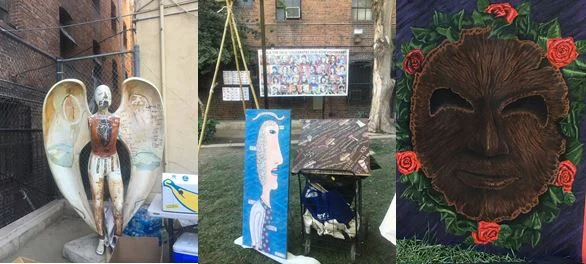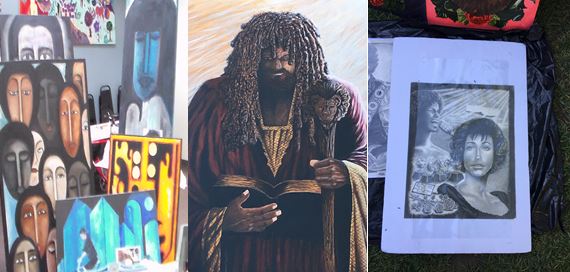What Does Art Do? Emblematic Representation and Performance Among Skid Row Artists
/This is the first of a series of posts written by the PhD students in my seminar, Public Intellectuals: Theory and Practice. This professional development course, offered by USC Annenberg School of Communication and Journalism, explores many different public dimensions of scholarship and teaching, including blogs, podcasts, op-eds, digital humanities, and policy white papers. Over the next two weeks, I am going to be sharing what the students produced on the blogging assignment. I know they would love to see feedback from readers.
What Does Art Do? Emblematic Representation and Performance Among Skid Row Artists
by Hoan Nguyen
I had an appointment with Jane on a Friday morning in Skid Row, an isolated neighborhood located just east of downtown Los Angeles. We wanted to meet at the Los Angeles California Action Network (LA CAN) where she infrequently came to play the piano in the Freedom room. She showed up very early,looked excited when I brought a camera ready to record her performance. Unfortunately, the Freedom room was fully occupied with people preparing for a party to celebrate the life of Fela Kuti – a Nigerian musician and activist. Jane’s face melted on hearing the news. Apparently she had carefully prepared for the “show”, wearing a nice grey suit and a beautiful bracelet: just one day earlier when I bumped into her for the first time, she looked pale in a wear and tear outfit, sitting on a fragile chair on the sidewalk.
So we sat down for a long conversation in the LA CAN library instead. Jane eagerly shared her life stories: one of the most educated women in Skid Row, she was trained in a reputable music department at high school, and got a college degree in nursing in Indianapolis. She used to work in a music studio, writing songs and co-producing music, before sliding into homelessness. She talked a lot about her childhood growing up in a church where she sang and created songs for the church choir. Religion is a major part in her life; and so is music. “God brought me here in Skid Row,” she said.
As a homeless artist, she had no musical instruments at hand except her voice. The Freedom room is her beloved place, where she can still play the piano. She sang emotionally a couple of times during our conversation. Songs heal her soul. Music tells her stories.
“(Music) is my voice to the world. And I've been given a gift. And I've been trained. I don't have any complaints about my singing or playing. And what's more than is that it touches people’s heart. People who live here like me who I play in front of. Some are Skid Row residents, some work here. Some of them are at Union Station and they're profoundly touched by what they hear.”
My encounter with Jane led me to wonder about art, performance, and their underlying meanings in the lives of Skid Row artists. Historically being treated as an urban ghetto hosting abandoned people as the disabled and the mentally ill, Skid Row is rarely associated with art. Art was not my initial research agenda, either. My ethnographic journey, however, awakened my curiosity and fascination with the role of non-mainstream art in this space.
So what do art and art performance do here?
At first glance, art is a means for individuals’ creative expression, which is perhaps a shared role of art for any artistic community! However, specific to Skid Row, art and performance, as revealed in Jane’ narratives, is associated with the creators’ personal experiences as homeless people. My fieldwork gave me more insights into the lives of these artists and musicians. I learned that homeless people use art to reflect on their transient lives on Skid Row streets, and beyond that, their desires to connect with the outside world. Aside from songs, there were paintings, zine collections, spoken words, and music video production, among others.
As with Jane’s, I was impressed by Pepper’s story. I met him at the Skid Row farmers’ market on a bright morning. He is a painter. People in the vicinity told me that he drew some of the best graffiti on various walls around Skid Row. During our in-depth interview, I asked him about the subject matter of his paintings and what messages he wanted to share with his audiences. He shared that his drawings told stories about beautiful things he noticed around him.
“What about the flowers? What about the wild birds in the air? Do you care about those? So you see I deal with reality. I don't butter stuff up. If it's going to rain, I'm going to tell you it's going to rain and you might want to get ready. I'm like, hold up. Hold up. Hold up. Isn’t that rain is a good thing, right? It refreshes the air, it brings new life […]
Love, you knows, no hatred, love is beauty. Love is peace. Love is happiness. Paintings and drawings are somewhat the same as a song cuz they talk about love. Okay, my job is to bring peace of love. When I die, the next generation young kids can guide them do much. Just saw. I can show that you need no gun. You need not worry. You don't need to be fighting to be you. Love, you know.
He also composes song lyrics and co-produces some music videos circulated on YouTube. He showed me his popular video, namely Everlast’s “Long At All,” within which he is the main character, telling stories about war, life in street, and the ephemeral nature of human life.
As my urban ethnographic journey advanced over the course of four months, I realized that individual work, like that of Jane and Pepper’s, is but part of a bigger picture. The other part, well organized and more publicized, is collective work buttressed by arts-based organizations and activists in the locality. Major organizations include Studio 526 and Urban Voice Project where Skid Row artists congregate frequently to practice and perform. There is also an annual art festival, namely Festival for All Skid Row Artists, deemed to be the central art event established to create a public space for Skid Row artists to showcase their works, celebrate their lives, interact with one another and the general public.
I went to the 9th Festival for All Skid Row Artists taking place at San Julian Parkin early November 2018. I was thrilled when seeing many artists displaying their works and performing on stage during the two-day event.
Artworks displayed at the 9th Festival for All Skid Row Artists, November 2018
In tandem with the annual festival, the Urban Voice Project held a performance event at the Central Library in downtown Los Angeles, which attracted the general public.
Looking into these well-organized activities and public events, I recognized their profound implications for the homelessness and artist identities and politics of resistance that went beyond individualistic experiences. Arguably, public performances and art displays, taken together, told a story of a unified community of homeless people in Skid Row. A story of a landscape of despair. A story of the transient lives being sidelined into marginalization and isolation.
Skid Row Zine:Lost/Found
Singing a beautiful song or performing spoken words on stage, the artists also asked the public to not look down at Skid Row, but instead, to listen to its people’s stories and understand their daily struggles. They showed a strong sense of resistance against housing injustices and social discrimination.
At the very least, art is also a space for the creators to strategically represent their collective identity as a valued community of creativity, dignity, connectivity, and love.
Unfortunately, the dominant discourse, both in academia and the wider society, is often skewed towards seeing art mainly as a therapy employed by social service providers to help the homeless heal their mental health problems. With that misconception, the homeless are perceived as a social problem, and so Skid Row is seen as contaminating rather than generative.
My involvement with the community, however, suggests otherwise. I realized that Skid Row art makers are true artists. Their artworks are in turn not simply healing therapies but a tool for creative expression, collective representation and resistance. Performance is their social justice project. Art could be a powerful bridge connecting Skid Row and the outside world.
Being one of the most stigmatized populations in America and elsewhere in the world, homeless people are more often than not physically isolated, subject to discrimination, and socially invisible. When mentioned at all, they are likely to be belittled as the disabled and passive receivers of social assistance. Outsiders hardly see any potential in them, unaware of the fact that there might be talented artists.Such expressions might invite us to rethink stereotypical assumptions. More importantly, we need to open our heart to listen to their stories and make changes in their lives through everyday practice. It can be as simple as looking at homeless people differently as they approach us on the side walk, engaging them in conversions about their life, or lending support to arts‐based organizations. Policy makers and the general public alike need to better understand the community’s lived experiences on the ground. They have to identify not only the marginalized people’s problems but also their potentials, aspirations, and agency. Only then can we meaningfully engage with the people who are living with the problems confronting America’s cities.
Hoan (Sarah) Nguyen is a doctoral student and graduate fellow at the Annenberg School for Communication and Journalism, University of Southern California. Her research interests include social inequality, digital divides, human agency, discrimination in the digital media, and technology for social change. Her studies examine social implications of technology use, role of digital media such as the Internet and mobile platforms in transnational migration processes and the empowerment of marginalized communities.




